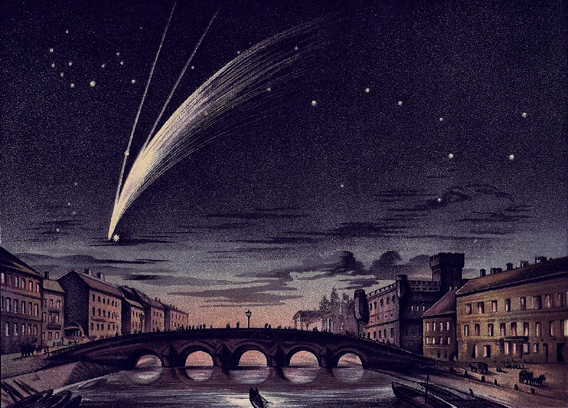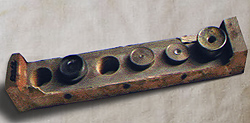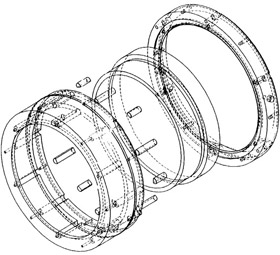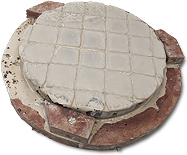 |
 |
 |
 |
 |
 |
 |
 |
 |
 |
 |
 |
 |
 |
 |
 |
 |
|
 |
 |
 |
|
 |
 |
 |
|
 |
 |
 |
Grateful thanks to all those that have provided many of the articles, references and details in these pages
This is a non-profit site |
| |
| |
| |
| |
| |
| |
| |
|
 |
Thomas Slater 1817 - 1889
One of the finest optical technicians in the 1840s. He made good use of his credentials having a fairly high opinion of his own talents.

At his address in London he had his own skillfully made 15-cm aperture refractor through which he observed Donati's Comet. It was Rev. John Craig who had prevented Slater from correcting the errant 24-inch lens of the huge Wandsworth telescope.
Thomas Slater was born in Barnwell, Northampton in 1817. At the time of Craig's telescope, he was living at 4 Somers Place, West Euston Square and was married to Maria, three years his senior. Slater was probably one of the finest optical technicians living in London in the 1840s. How or why Craig or Gravatt came to choose Slater to figure the lenses of this telescope is not known. Whilst Slater had figured fine lenses in the past, he certainly made good use of his credentials having a fairly high opinion of his own talents; in a report about the Craig Telescope in the Annals of Science he even made the claim shortly after the telescope was finished that he was, "ready to undertake an object glass of 6-feet diameter if require".
At his address in London he had workshops and even a well equipped observatory housing his own skillfully made 14.78-inch (37.54-cm) aperture refractor through which he was to observe Donati's Comet.
He worked on occasion with an tool-making engineer by the name of Joseph Tall.
 |
|
 |
 |
Some of Thomas Slater's eyepieces.
|
|
 |
 |
Towards the end of the 1800s, the area around Euston was completely redeveloped. Today, the site of 4 Somers Place is located near the corner of Euston Road and Charlton Street - more or less on the site of the present University College London Hospital.
It is probable that Craig had asked several lens makers to take up the challenge of the world's largest achromatic lens before he came across Slater. One such individual would probably have been Andrew Ross. He was well known to several eminent astronomers including George Biddell Airy, the Astronomer Royal at that time, who said in a report of the British Association for the Advancement of Science in 1851, "The removal of the vexatious fiscal interferences with the manufacture of glass, and the enterprise with which Mr Chance as manufacturer and Mr Simms and Mr Ross as opticians, have taken up the construction of large object-glasses, promise to lead to the most gratifying results. Already Mr Simms has partially tested object glasses of 13-inches aperture; and one of 16-inches is waiting not for the flint but for the crown lens. Mr Ross, it is understood, has ground an object-lens of 2-feet aperture; but it has yet to be tested". Perhaps Mr Ross turned down the offer because he was already committed to the construction of several large aperture lenses.
back to top of page >>
We know nothing of the work Slater put into the project, but we do know that it was probably done at Somers Place and that it was not a total success; one of the lenses being slightly undercorrected.
 |
 |
| |
 |
 |
 |
| |
A schematic showing how the cell and the doublet lens of the Craig Telescope were probably fitted together by Slater. |
 |
 |
In an address called On Photographs of the Moon and of the Sun by Rev J B Reade held at liverpool in September 1854, Reade mentions, "the present superiority of the telescope, though confessedly admitting of improvement in figure" suggests that the trials on the telescope had already shown it to be in need of further refinement, at least optically. Later in the same article, we also learn that Slater polished the lenses by hand and did not use the assistance of a machine. The shear weight of the glass blanks alone would have meant that the job of polishing and figuring the lens shapes would have been quite a task in itself.
In an article in the Illustrated London News, 16th October 1852, it suggests that it was Craig that intervened in preventing the lens being corrected by Slater, stating, "Mr Craig seems to think, were he to attempt to have this five thousandth part of a inch corrected, it might be over-corrected the other way, and thus more harm than good be the consequence".
Slater was never a man to be left out in the public eye, taking every opportunity to get his name recognised. An article in The Times, shortly after the telescope was announced to the public, failed to mention the part Slater had played in the project. Slater wasted no time in berating the the editor in a letter that he would later regret having written, "Your correspondent has given a fair statement about all concerned in this instrument, with but one exception - namely, your humble servant, who was the first to undertake to make this telescope, and the object-glass and all the optical work were contracted for and worked by me. If there is any merit in this great undertaking, let me have my share of publicity."
back to top of page >>
Mr Slater also figured all three eyepieces for the Craig Telescope using a lens making machine at his workshops in Euston. There are no reports of these being poorly figured.
It is clear that Slater was a keen observer at his address in Euston, for in a letter mentioned in the Monthly Notices of the Royal Astronomical Society, (Vol. 19, p.291) in 1859, he had seen an unusual object in the constellation of Boötes which he had observed for some time. The date would also suggest he had not been too affected by the Craig Telescope incident.
By the time of the 1881 census, Slater had remarried, Adelaide Smales, and had had a son, George Mewburn who was 10 years old at the time. Now calling himself a civil engineer Slater and his family had moved to 19 Leamington Road Villas, Paddington. His son, George, became an actor performing mainly in pantomimes and melodramas. Later George became a theatre manager having written several pantomimes. Although he married Alice Opptiz in 1900, it seems they had no offspring. George died in 1949 in Holborn aged 79.
back to top of page >>
|
 |
 |
 |
 |
| It seems that Thomas Slater was perhaps one of the finest optical technicians in the 1840s. He was certainly eager to experiment with the possibility of producing very large object glasses. |
 |
|
|

